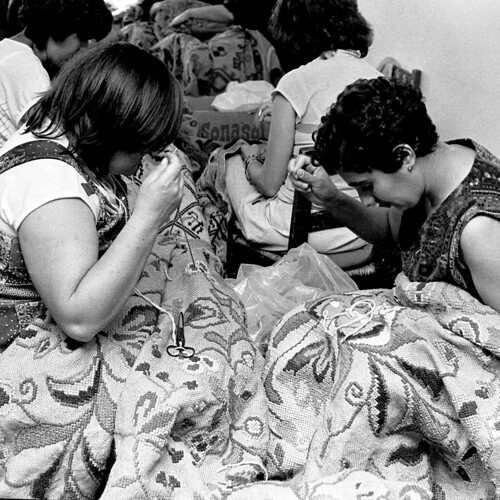"An embroiderer is the woman who embroiders rugs and must have patience and ingenuity. The visitor that comes to Arraiolos will easily find women and girls embroidering rugs at the doorstep of their homes. In ancient times, embroiderers copied directly from the patterns that were hanging on the wall ahead. Nowadays they copy down the pattern from a graph paper. There would be no Arraiolos Carpets without embroiderers. A resourceful and experienced embroiderer needs 15 days to complete one square meter."(1)
 |
| Drawing representing a needlewoman from Arraiolos made by the authors of the text |
Arraiolos is type of counted thread embroidery using wool thread on fabric which can be jute or linen. The world-famous Arraiolos Stitch is a long-armed cross-stitch, the basis of the technique used in making these carpets, but it was not born there. The first documentation on the use of this technique comes from the 12th century in Spain, while the first reference to a rug made in Arraiolos dates to 1598. Only later this stitch gained the "Arraiolos" designation but nowadays it is known as that almost everywhere.
And history tells us more... The first embroiderers of these rugs were middle class women, living in the urban area of Arraiolos for whom embroidery was a domestic and not commercial activity.
 |
| Needlewoman from Arraiolos, photo by Cida Garcia |
But how is that we find such an impressive craft treasure from long long ago in a small village, far from the capital? History explains it...
With the expelling of Jews and Moors from Spain by the Catholic kings and the beginning of the exodus, along with the temporary settlement of these peoples in Portugal, until 1511 -- when Manuel I forced them to resume their journey to the north of Africa -- various people decided to settle down in Arraiolos, due to the warm welcome, the abundance of herds, of excellent wool and the diversity of plants, indispensable to the dying and making of canvas, together with the sensitivity and work capacity of the villagers. (2)
 |
| Women embroidering, photo by Fernando Ricardo |
Documents also show that in addition to the local importance of wool production, there was an intensive textile activity with the presence of many professionals needed to the rug's execution. It was known that carpets were made by Jews and Moors in Lisbon before they left the town. So it is plausible that the coincidence of experienced carpet makers joining the materials and textile professionals gave birth to this treasure of Portuguese culture.
However...In the end of the 19th century, the making of Arraiolos rugs practically did not exist... With the beginning of the 20th century, the "rebirth" of the Arraiolos rugs occurs -- a group of women from the village recreated models, based on those which, in different eras, had been unsurpassed examples of the Arraiolos rugs, thus creating a new era.(2)
 |
| An Arraiolos Carpet in the street, photo by Rosa dos Ventos |
Recently in Arraiolos a monument was built paying homage to Arraiolos' needlewomen. The author of the monument justifies it:
"(the embroiderers) patiently dominated the motifs of birds, flowers, medallions, geometrical bars, developing a decorative art that settled in the daily life of population. Carpets are intimately related to the way of life and sociability of Arraiolos providing unique moments of familiarity: we see groups of women sitting in the shade of the houses and walls, in the long and bright days, patiently embroidering rugs then installed in the interior of homes. The needlewomen are, still today, the foundation of a cultural circuit that connects the house to the street and Arraiolos to the rest of the world."
 |
| Embroiderers in the streets of Arraiolos, photo from here |
Let me end with a legend, the Forever Bride, which show us how rugs are so deeply rooted in local traditions.
There was a young damsel who was engaged at the time when there was ongoing wars between the Christians and the Moors. As the village was attacked, her betrothed had to leave for combat. It was a long time before the groom returned and grieving at the loss of youth it took him a long time to resurface. When the bride eventually showed up for the wedding, she covered herself with a rug to hide the marks of time. (3)
 |
| Arraiolos Carpets in the streets of the village, photo by Rosa dos Ventos |
(This "story" on Arraiolos Carpets History is not closed. Other theories have been proposed and new evidence were discovered - here and here you'll find more information.)




Interesting and educational post. Nice.
ReplyDeletegreat post! thanks for all the info, links and delightful pics :-)
ReplyDelete